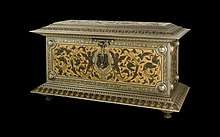Damascening
Damascening is the art of inlaying different metals into one another—typically, gold or silver into a darkly oxidized steel background—to produce intricate patterns similar to niello. The English term comes from a perceived resemblance to the rich tapestry patterns of damask silk.
Background
The technique, while also being used on firearms, has a long history in Japan, where it was used to decorate katana fittings, particularly tsuba. Known as zougan (象嵌) in Japanese, it has developed its own subset of terms to describe the particular patterns, although "shippou-zougan" is an enamelling technique which most Westerners would consider closer to champlevé.
Damascened-inlay jewelry, especially of Japanese origin, is sometimes referred to as shakudo from the use of that alloy as the dark background.
The technique of niello is also famously attested in prehistoric Greece. The earliest occurrence of damascening in the Aegean, from the Shaft Graves of Mycenae, dates to the latest Middle Bronze Age/Middle Helladic IIIB period (dagger Nu-304). Ultimately of Near Eastern provenance, the technique of inlaying silver/gold was adapted to suit Aegean taste and style.
Cities that are known for a rich history in Damascening where the technique is still practiced are Malaysia, Indonesia, Toledo, Spain, Eibar, Basque Country (Spain) and Kyoto, Japan.
Eibar, Spain

The Zuloaga family workshop at Eibar was the centre of Spanish damascening from the 19th century to the Spanish Civil War.[1][2] Eusebio Zuloaga was a gunsmith and director of the Spanish Royal Armoury.[3] A metalwork prodigy, Zuloaga undertook to restore damaged items in the armoury, and in the process studied and replicated decorative techniques of centuries past. This led to the establishment of Spain's damascene industry.[4] Eusebio's eldest son Plácido Zuloaga eventually took over the workshop and directed its work away from armaments to the production of intricate decorative art works.[3] In the process, he mastered and improved the techniques of damascening[5] and trained more than two hundred artists.[1] His works were exhibited at many national and international fairs, winning multiple gold and silver medals[1] and extremely positive reviews from critics.[6] The British-Iranian scholar and collector Nasser D. Khalili has assembled, published, and exhibited more than a hundred items of Spanish damascened metalwork from this period, forming one of his eight collections.[7]
Toledo, Spain

Toledo has long been the major European centre, although most modern production is machine made, sometimes on tin rather than steel. Nevertheless, the art has long been practised in Persia, Japan and China.
Some of these reproductions are "so expertly produced that even knowledgeable Toledeans admit the difficulty of recognizing them as such."[8]
Damascene work has kept to traditional designs with few changes over the years, but there are a few artists who design innovative pieces of jewellery. Because of these reasons the use of this technique has been most popular in Spain.
Fujii, Japan
One of the most important Damascene creators was Fujii Yoshitoyo from Kyoto. He was born in 1868 and invented new techniques for the art of damascening. His designs were drawn by Bisei Unno of the Tokyo Fine Art School. He operated the Fujii Damascene Company from about 1925 through the mid 20th Century. In many exhibitions of this kind, Fujii was awarded first class medals for his exhibits, and his works have been purchased by the Imperial Household. Although Fujii's works are extremely detailed and very similar to the, for example, Komai's works, they are done in the etching technique and not in Zogan. Because Fujii's company was called "Fujii Damascene Co" or "Fujii Zogan Co" there should be arts he made in a Zogan technique, but until now, none of these were discovered. [9]
References
- Lavin 1997, p. 63.
- Khalili, Nasser D. "Foreword" in Lavin 1997, p. 8
- "Plácido Zuloaga y Zuloaga | Real Academia de la Historia". dbe.rah.es (in Spanish). Retrieved 2020-04-09.
- Lavin 1997, p. 34.
- Larrañaga, Ramiro "Damascene as part of the Engraver's Art" in Lavin 1997, p. 37
- Blair, Claude "Introduction" in Lavin 1997, p. 9
- "Spanish Damascene Metalwork". Khalili Collections. Retrieved 2020-04-09.
- "DAMASCENE WARE IN SPAIN'S TOLEDO". The New York Times. 1982-04-11. ISSN 0362-4331. Retrieved 2016-06-20.
- "FUJII YOSHITOYO". www.smokingsamurai.com. Retrieved Apr 13, 2020.
Sources
- Lavin, James D. (1997). The art and tradition of the Zuloagas : Spanish damascene from the Khalili Collection. Oxford: Khalili Family Trust in association with the Victoria and Albert Museum. ISBN 1-874780-10-2. OCLC 37560664.CS1 maint: ref=harv (link)
External links
| Wikimedia Commons has media related to Damascening. |